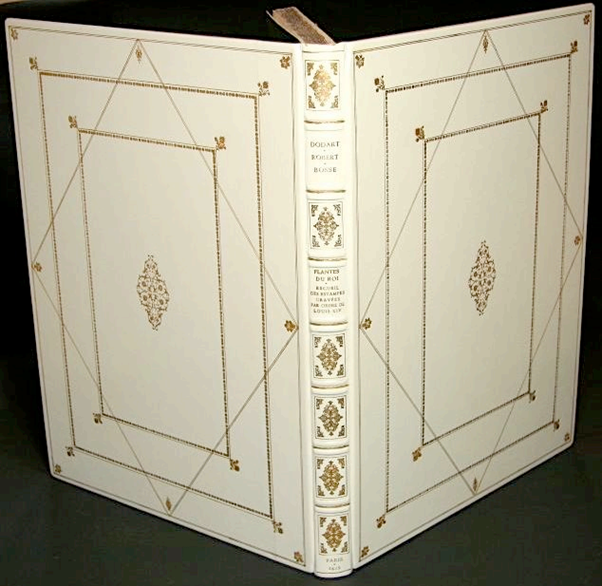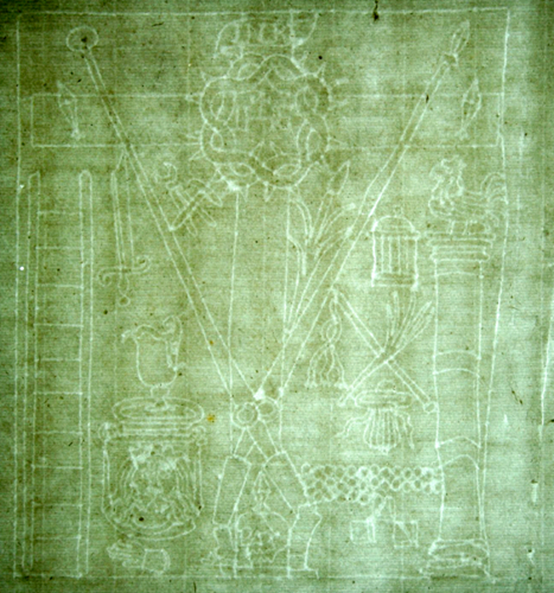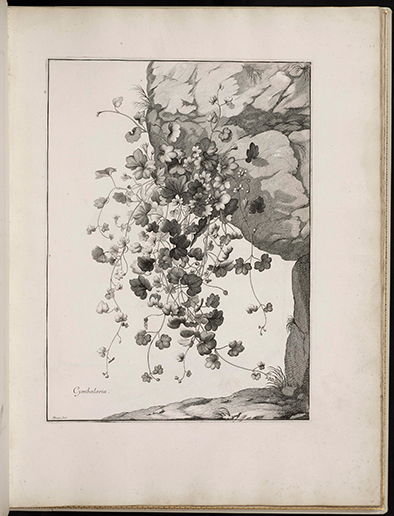Plantes Du Roi
Plates engraved by Nicolas Robert (1614-1685) and Abraham Bosse (1604?-1676)
Series of 89 engravings. Sheet sizes: 55.7 x 41.5 cm.
[DODART, Denis] [Estampes pour server à l’histoire des plantes.] [N.p., n.d., but Paris after 1672 and before 1676]
Broadsheets in-plano, Raisin format, tipped to stubs (the pages 21-7/8 x 16-3/8 in.; 55.7 x 41.5 cm). 89 plates engraved by Nicolas Robert and Abraham Bosse after the drawings by Robert, printed rectos only with engraved Latin titles (and on 20 plates with additional engraved French titles) but otherwise without text. Ivory Morocco (22-3/8 x 17-3/8 in., 56.8 x 44.3 cm) spine in eight compartments with raised double bands and elaborate gilt tooling, covers with gilt ruled panels, central medallion and corner tools, striated verde green Asahi cloth doublures, endpapers marbled in French curl, all edges with old gilt. Collates 91 ll.: [1l.], 89 ll. plates, [1 l.], with [3 ll.] front and back for doublures, endpapers and binder's blanks. Fine retrospective Baroque design binding, by Nello Nanni, in a complementary Half Morocco Clamshell box. The text block is tight, square, strong and flat-opening, the leaves in generally bright original condition, traces of old creasing to blank end leaves. The plates have unobtrusive scattered foxing, staining and edgewear, unobtrusive pencil numbering on all plates, a small ink stain at lower fore-edge of last 60 plates, and the first and last plates with some restored marginal tears and fraying.
Fine retrospective Baroque design binding, by Nello Nanni, in a complementary Half Morocco Clamshell box. The text block is tight, square, strong and flat-opening, the leaves in generally bright original condition, traces of old creasing to blank end leaves. The plates have unobtrusive scattered foxing, staining and edgewear, unobtrusive pencil numbering on all plates, a small ink stain at lower fore-edge of last 60 plates, and the first and last plates with some restored marginal tears and fraying.
Appointed in 1664 as Peintre Ordinaire de Sa Majesté pour la miniature, and continuing in Paris and at Versailles the work he had begun for Gaston d'Orléans at Blois, Robert was chosen as chief illustrator when the newly founded Académie Royale des Sciences decided to publish a Histoire des Plantes. The original idea, conceived by Perrault and enthusiastically received by Colbert, began to come together when the botanist Denis Dodart (1634-1707) joined the Académie in 1673. Dodart's Mémoires pour servir à l'Histoire des Plantes, intended as a preliminary volume introducing the project, appeared in 1676 and contained 39 plates by Robert and Bosse, together with descriptions on facing pages, principally by Nicolas Marchant, director of the Jardin du Roi. On the frontispiece, the celebrated engraving of 1671 by Jean Goyton after Sébastien I Le Clerc, depicting an imagined visit by the King to the Académie hosted by Colbert in a museum-like room overlooking the Jardin des Plantes.
Putting his painting on vellum to one side, and assisted or even directed by the master engraver Bosse, Robert engraved numerous plates for the collection. After Bosse's death in 1676, Louis de Châtillon joined the project, and an issue with 272 plates engraved by Robert, Bosse and de Châtillon was printed around 1685, soon after Robert's death, to exhibit the work in progress to the Académie. Thereafter de Châtillon continued the work alone, and 319 finished plates were deposited with the Imprimerie Royale in 1692.
The 319 plates were first issued as a completed series in 1701, without text or title, but often described as Estampes pour servir à l'histoire des plantes. From the time of the 1676 Mémoires the engraving on many plates has evolved, with additional plant details, amended Latin or additional French engraved plant names, and alterations to the authorship inscriptions, culminating probably with the 1719 re-engraving by Jean Marchant (son of Nicolas), in conformity with Tournefort and Vaillant. In 1786 a royal gift issue was published, still without text or title but reviving the Le Clerc frontispiece (effacing Goyton's role).
During the period from 1685 through the gift issue of 1786, occasional collections of varying numbers of the plates, on rectos only and without text, were printed ad hoc and given as gifts. A new three-volume issue of the completed series of 319 plates was published in 1788, finally with descriptive text (the first since Dodart's and Marchant's in 1676), under the title Recueil des plantes gravées par ordre du Louis XIV. None of the issues were ever sold to the public, and any collection of the plates assembled after the 1676 Mémoires represents a great rarity. We are aware of only four sets in North American institutions with complete collections of the hors-texte plates datable from 1701 but before the 1719 re-engraving, and only two copies worldwide of earlier "in-progress" issues dating to around 1685 (the de Belder set, last at auction with Christie's, June 4, 1997, no. 37, and possibly Bibliothèque Centrale du Muséum National d'Histoire Naturelle 63 606 GF, see Bréchot, Laissus and Guédès, infra, at p. 370). Moreover, we are aware of only two other collections of plates worldwide which compare to the present collection (Bibliothèque Nationale S-266 and Bibliothèque de l'Institut de France Fol DM 211; see discussion below and in Bréchot, Laissus and Guédès, infra). A worldwide census of all issues through 1788 is available on request.
This collection of 62 brilliant plates engraved by Robert and 27 by Bosse (not including any of the subsequent plates by de Châtillon) after Robert's drawings in sanguine on laid tissue, preserved in the Muséum du Jardin des Plantes, gives every indication of having survived as an assembled set from an early date. It represents a selection of first-issue plates and lettered proofs some of which demonstrably predate the 1676 issue of the Mémoires. In the 16 plates common to this collection and the Mémoires, the additional engraved French title appears, in every case, on the plate from the Mémoires but not on the plate from this collection, and two plates from the Mémoires have additional engraved plant details not present on the corresponding plate in this collection. All the plates in this collection are printed on fine laid paper with 18 chain lines per page oriented horizontally, all with the B[enoît] Colombier (Auvergne) watermark of the second half of the 17th century* (the name within two concentric ovals, overall generally about 7 x 7 cm, enclosing a bunch of grapes having five or six grapes in the centre of the bunch, "N" or reflected "N" for "M," fleur-de-lis spacers between "R" and "B" and "C"). The blank endleaves are of old laid paper, likely from the same general stock, having the same laid line measurements (the chains oriented Plantes du Roi -3- vertically) and bearing large and elaborate watermarks 23 x 19 cm. The main features of these watermarks are central crossed lances tipped with the spear and the sponge, surmounted by an intertwined double quatrefoil crown with thorns centring a stylized "IHS" and a banner above with "INRI," a ladder on the left and a pillared post with perched eagle on the right, various other Christian and saints' symbols arrayed to the sides. The Bibliothèque de l'Institut de France possesses a volume of 90 leaves catalogued as Fol DM 211: "Plantes du Roi: recueil de 90 planches gravées par ordre du roi Louis XIV constituant le 1er tirage [c. 1672] des planches préparatoires à l'Histoire des plantes de l'Académie." The volume in the Institut, from the library of the botanist and académicien des sciences Benjamin Delessert (1773-1847), comprises two blank endleaves having the same distinctive large watermarks evidenced in this collection and 88 plates by Robert and Bosse, identical to the plates in this collection with the sole exceptions that the Institut's volume includes two plates by Robert not present in this collection but lacks two plates by Robert and one by Bosse present in this collection (private communication, March, 2007).** The dating of this collection, like the one in the Institut, before rather than after the 1676 issue of the Mémoires is reinforced by a comparison of this collection with a set from the 1701 issue, revealing many further instances of engraved alterations, additions and relative wear in the 1701 plates. A complete annotated list of the plates included in this collection is available upon request.
The conclusion that this collection is datable before the 1676 issue of the Mémoires is supported by the analysis of Bréchot, Laissus and Guédès, infra, in their 1974 "Note bibliographique sur les 'Plantes du Roi'," of the 90-plate set, Bibliothèque Nationale S-266, and a set of 40 coloured plates, Bibliothèque Centrale du Muséum National d'Histoire Naturelle, in each case itemised in an Annexe to the cited note.
These plates have the B Colombier watermark described above. Every plate in the present collection is also present in Bibliothèque Nationale S-266, which has only one plate, Robert's "Helleborus niger legitimus," not present in this collection. 32 of the 40 colored plates in the Bibliothèque Centrale du Muséum set are common to the present collection and Bibliothèque Nationale S-266. Bréchot et al. conclude: "Peu avant la publication de la première édition des Mémoires de Dodart, contemporaine de la mort d'Abraham Bosse, on tira donc les planches disponibles, sans doute en très peu d'exemplaires. Ce tirage eut bien lieu avant la publication des Mémoires de Dodart, car des modifications furent faites sur les cuivres avant de les utiliser pour ce dernier ouvrage. Les planches de Dodart ont déjà une double légende latine et française lorsqu'elle est seulement latine dans le tirage qui nous occupe. Pour le Clematis americana..., une fleur a été ajoutée dans Dodart, et elle subsistera dans les tirages postérieurs. Il en est de même d'une figure de détail à gauche dans la planche consacrée au Sanicula sive Cortusa indica..." (p. 374).
As noted by Lucia Tongiorgi Tomasi, infra, p. 168, "The Recueil des plantes was judged by the master flower painter Gerard van Spaendonck to be the most beautiful botanical work ever published.... The plates engraved by Robert are instantly distinguishable by the lightness of his touch and by the sensitive modulation of the various tones of grey and black in the leaves and flowers." Wilfrid Blunt, infra, likewise highlighting van Spaendonk's judgment ("in an age which knew the lovely work of Ehret and Redouté"), deems the book a landmark in botanical illustration, the finest collection of flower engravings made during the 17th century. * Note on watermarks: see Edward Heawood, Watermarks, mainly of the 17th and 18th centuries, Hilversum, 1950, nos. 2426-31, particularly 2430, datable to Paris 1670; and Pierre Delaunay, Catalogue des filigranes relevés sur les papiers d'archives d'Auvergne, Clermont-Ferrand, 1997, nos. 1853 and particularly 1854, p. 130, ill. p. 309, the latter datable to 1674 based on Clermont-Ferrand Archives Départmental no. 4G 35. Delaunay, supra, observes that the cited watermarks identify both the papetier Colombier (from Ambert à Livradois in central-east Auvergne) and the format of the paper, le raisin, of which the sub-format le carré au raisin measures typically, as in this collection, from 40 x 56 cm.
* Note on watermarks: see Edward Heawood, Watermarks, mainly of the 17th and 18th centuries, Hilversum, 1950, nos. 2426-31, particularly 2430, datable to Paris 1670; and Pierre Delaunay, Catalogue des filigranes relevés sur les papiers d'archives d'Auvergne, Clermont-Ferrand, 1997, nos. 1853 and particularly 1854, p. 130, ill. p. 309, the latter datable to 1674 based on Clermont-Ferrand Archives Départmental no. 4G 35. Delaunay, supra, observes that the cited watermarks identify both the papetier Colombier (from Ambert à Livradois in central-east Auvergne) and the format of the paper, le raisin, of which the sub-format le carré au raisin measures typically, as in this collection, from 40 x 56 cm.
Please click on show additional information below to view further notes and literature.
Price on Request
Related Literature:
Blunt, Wilfrid, The Art of Botanical Illustration, London: Collins, 1951 (2d ed.), pp. 109-12 and pl. XVII.
Bréchot, Jean-François, Laissus, Yves and Guédès, Michel, "Note bibliographique sur les 'Plantes du
Roi'," Revue française d'histoire du livre, V (nouvelle série), 8 (1974), pp. 369-380.
[Hunt, Rachel McMasters Miller] [Quinby, Jane, comp.], Catalogue of Botanical Books in the Collection of Rachel McMasters Miller Hunt, Pittsburg: Hunt Botanical Library, vol. I, 1958, no. 343, pp. 365-7.
Lassius, Yves, Nicolas Robert et les vélins du Roy au Muséum national d'histoire naturelle, Paris: Henri
Scrépel [ca. 1980].
Nissen, Claus, Die botanische Buchillustration, Stuttgart: Hiersemann, 1951, v. I, pp. 97-8; v. II, nos.
502-4, pp. 48-9.
Rix, Martyn, The Art of the Plant World, Woodstock: Overlook Press, 1980, pp. 61-3.
Sitwell, Sacheverell and Blunt, Wilfrid, Great Flower Books, 1700-1900, New York: Atlantic Monthly
Press, 1990, pp. 29-30, 91.
Stroup, Alice, A Company of Scientists: Botany, Patronage, and Community at the Seventeenth-Century Parisian Royal Academy of Sciences, Berkeley: University of California Press, 1990, particularly ch. 6, "The Natural History of Plants: Rival Conceptions."
Tongiorgi Tomasi, Lucia, An Oak Spring Flora, Upperville: Oak Spring Garden Library, 1997, no. 43,
pp. 167-70.
________________________________________________
(* Note continued)
Delaunay, supra at pp. 25-6, states further that Auvergne and Ambert in particular excelled at the raisin format and quotes Father Imberdis's 1693 poem "Papyrus sive Ars conficiendae Papyri" printed in Clermont, extolling Colombier's paper specifically over some 70 lines ("Il est une sorte de papier dont la feuille est plus grande et qui consitute le chef-d'oeuvre d'un art admirable....").
**Note on gatherings: There are old binder's gathering numbers penciled at the extreme lower left corners of selected plates of this collection. These numbers evidence old gatherings of the leaves into groups of six: plate 7 has "2"; plate 13, "3"; plate 19, "4"; plate 25, "5"; and so forth. The sole exception is that the group from plate 43 ("8") to plate 53 (before plate 54, "10") comprises 11 leaves instead of the expected 12 (2 x 6) leaves. Interestingly, both the "1672" set Fol DM 211 in the Bibliothèque de l'Institut de France and the Bibliothèque Nationale set S-266 include the "Helleborus niger legitimis," which is not in this collection but would fall between plates 51 and 52 in this collection, thus making up the expected gathering of 6 (or 12) leaves.
